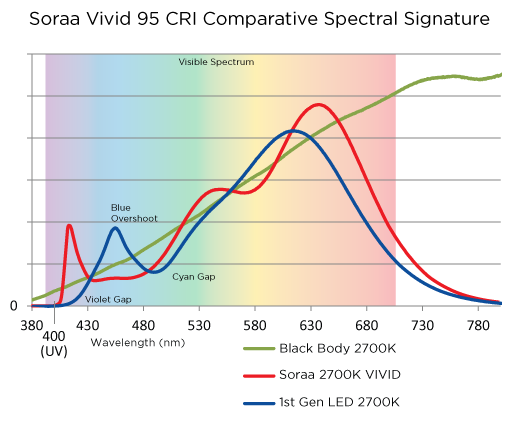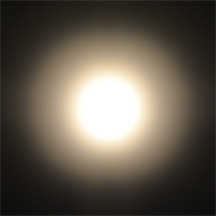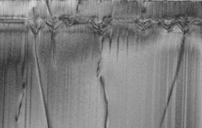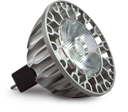SORAA LED for Track Lighting
SORAA Questions & Answers
What is the benefit of having a single LED source in a light bulb?
A single LED source ensures crisp single shadows with only one color. Lamps with multiple LED sources project multiple shadows with multiple colors, yielding less attractive results on objects being displayed. Even halogen MR16 lamps, because they have multifaceted reflectors, do not project shadows as crisply as single LED lamps.
Soraa's LED MR16 single source yields a single crisp shadow and color.

Halogen Lamp

Soraa Lamp = Crisp Definition

Standard LED Lamp = Multiple Shadows/Colors
Why don't LED light bulbs make objects look the same color as halogen lamps do?
There are several reasons for this. Other LED lamps use a blue LED emitter with various phosphors to make the LED emit white light. The resulting LED spectrum does not exactly match the halogen black body curve for the visible light spectrum. It has a high blue spike and is missing part of the spectrum in violet and cyan. LED lamps also can have values either above or below the black body curve (u', v'), making the light look either more green or more pink than halogen. Although the corrected color temperature (CCT) may be the same value as halogen, colors and whites can look different.
Soraa's LED MR16 closely matches the black body curve, making whites and colors render more like halogen sources.
 BACK TO TOP
BACK TO TOP
Why do SORAA lamps get hot?
The short answer is that Soraa lamps get hot BECAUSE THEY CAN. Soraa's unique GaN on GaN LED design produces a perfect crystal structure with very few defects. Compared to LEDs made with GaN on non-native substrates, this structure allows 10X the current density to be driven through the LED, producing a very bright light while maintaining exceptional energy efficiency with minimal droop (loss of efficiency at high current). This power consequently produces heat, which must be dispersed efficiently in order for the LED to operate.
The fact that Soraa lamps are somewhat hot to the touch after being powered up is a good thing - it means that their unique heat sink design is very efficient at removing heat from the core of the lamp, the LED lightchip, where it is generated. Soraa LEDs are designed to run safely at temperatures up to 150°C, twice the temperatures of other LEDs, and comparable halogen lamps run hotter, up to 230°C.
BACK TO TOPSince SORAA lamps use a violet wavelength pump, do they emit uv?
No, Soraa lamps do not emit any UV. Soraa lamps use a violet pump that is above 400 nm, and emits no light in the UV wavelength range, which is 400 nanometers and below.
BACK TO TOPWhy is form factor important?
In order to insure that LED MR16 lamps fit into existing fixtures, they must meet the ANSI standard for halogen lamps. Some LED lamps exceed this form factor and do not fit into some existing fixtures. Also, most LED MR16 lamps weigh significantly more than halogen lamps, and may not be suitable for use in fixtures not designed for heavy lamps.
Soraa's MR16 lamp complies with the ANSI standard and weighs only slightly more than a typical halogen lamp.
 BACK TO TOP
BACK TO TOP
Why is overall beam pattern important?
There are 3 components of the beam angle in directional lamps: center beam candle power (CBCP), field, and spill. CBCP and field are what lighting designers consider as usable lumens. Lumens falling outside this area are called "spill." Designers try to eliminate spill by using baffles, lenses and other accessories. Many LED directional lamps only concentrate on CBCP, and produce minimal light in the field, so they miss a key component of good lighting design. Others have a significant amount of spill, so even if they have lumens in this area, these lumens are not considered usable. Most lamps have irregular beam patterns with many artifacts and poor center-to-edge color consistency. So when choosing an LED MR16 lamp, it's important to evaluate all the features of usable light, including CBCP, field, beam shape, and color over angle.
Only Soraa's LED MR16 lamp delivers a perfect circular beam, with the right amount CBCP and field, minimal spill, soft transitions and high center-to-edge color consistency.

Soraa Beam shown at distance of 1 meter from wall.

Typical Halogen Beam shown at distance of 1 meter from wall.
What is the difference between nec low voltage class 1 and class 2 systems?
The National Electric Code (NEC) defines and determines safety requirements for these systems. In terms of 12VAC lighting, NEC Class 2 low voltage systems are defined as systems using transformers that are 60W or less. These Class 2 systems have less stringent safety requirements than other systems. UL defines the transformer safety standards under UL1310: Class 2 Power Units.
NEC Class 1 low voltage systems are over 60W in 12VAC and have more stringent safety requirements. UL defines the transformer safety standards under UL1012: Power Units Other Than Class 2.
BACK TO TOPWhy is this distinction important?
Many LED MR16 lamps state that they are only for use in Class 2 systems. Using a Class 2 lamp with a power unit other than Class 2 violates UL and creates a potential safety issue.
Some LED MR16 lamp manufacturers say nothing about which UL transformers are suitable for use with their lamp, so it is unclear if they are UL tested for use with UL1012 transformers in Class 1 low voltage systems, or only rated for Class 2 applications with UL1310 transformers.
Soraa's LED MR16 lamp is the ONLY UL listed lamp that is specifically listed for use with both UL1012 and UL1310 Power Units in Class 1 and 2 low voltage systems.
BACK TO TOPWhat other requirements are important?
LED lamps legally must comply with FCC requirements, CFR 47 Part 15 and Part 18. Some LED lamps may not comply with this requirement and may be subject to FCC sanctions, including fines and recalls. Soraa's LED MR16 lamp complies with all FCC requirements, as tested by an independent certified laboratory.
BACK TO TOPWhat makes soraa's led mr16 lamp so different?
Soraa uses a fundamentally different LED crystal structure, one that allows the LED to operate at much higher levels and generate more lumens per area. Soraa's technology, based on GaN on GaN™ materials, produces a perfect crystal structure. All other LEDs are based on dissimilar crystal structures, which result in dislocations that adversely affect performance.
SORAA

OTHER LEDs

Perfect Crystals
All white LEDs are made from Gallium Nitride (GaN) crystals grown onto a dissimilar substrate. Sapphire and silicon carbide are used as the substrate for almost all LEDs made today.
 Only Soraa uses a perfectly matched GaN substrate to produce GaN on GaN™ LEDs. These perfect crystals produce more light per area than any other LED on the market.
Only Soraa uses a perfectly matched GaN substrate to produce GaN on GaN™ LEDs. These perfect crystals produce more light per area than any other LED on the market.
SORAA

OTHER LEDs

PERFECT LIGHT
Soraa LED lamps clearly illuminate you and your environment.
-
HALOGEN PERFORMANCE
The light output of Soraa lamps look as good or, in some cases, better than standard halogen lamps, offering better beams, patterns, and shadowing than halogens. -
A BETTER BEAM
Baffles, filters, and lensing are often needed to control the inefficient beam and unwanted light spill of halogen lamps. Up to 40% of the light output of halogen lamps is wasted in unused light. Soraa lamps have a perfect beam profile and do not require additional accessories to control the light. -
COLOR MATCHING
Similar to halogens, Soraa lamps emit a broad continuous spectrum. They render more of the color wavelengths than other LED lamps, making colors look more vibrant. -
COLOR CONSISTENCY
Spectral output is consistent from Soraa lamp to Soraa lamp. The color is controlled tightly, within a 3-Step MacAdam's Ellipse so that objects are illuminated consistently. -
COLOR OVER ANGLE
Soraa lamps maintain color control for uniform color rendering over all angular beam profiles.
PERFECT FIT
No more guess work. Soraa lamps fit and work safely wherever they're installed.
PERFORMANCE
No more blinking, buzzing, noisy LED lamps or ones that simply just don't turn on. Soraa lamps turn on and operate properly with both magnetic and electronic transformers.
CLASS 1 AND CLASS 2 LOW VOLTAGE TRANSFORMERS
Don't know what kind of transformer you have? It doesn't matter. While most LED lamps are designed to work only with Class 2 systems, Soraa lamps are UL listed for both NEC low voltage Class 1 and Class 2 transformers, so you can use them with any low voltage UL listed system.
UL SAFE
Many MR16 LED lamps are only R-UL rated, which means that they are UL recognized as a component but are not UL listed. The R-UL label means additional UL certification is required for installation in a UL listed fixture. Soraa lamps are fully UL listed, so you can trust them to work safely as a retrofit lamp in UL listed fixtures.
DIMMING
Experience perfected LED dimming. Unlike some competitive LEDs, Soraa lamps work properly with many commonly installed leading-edge and trailing-edge dimmers.
FIT
Soraa lamps conform to the ANSI standard, so they fit standard lighting fixtures when used as specified.
SORAA

single crisp shadow
OTHER LEDs

multiple shadows
("showerhead" effect)
PERFECT FORM
-
SINGLE SOURCE, SINGLE LIGHT
A high lumen density enables more light output from a single, small source, giving you more flexibility to design and control the lighting environment with a single visible point of light. -
MORE NATURAL
Soraa lamps give you halogen level performance from a single LED light source. This replicates halogen illumination, with one color and one shadow. -
ELEGANT DESIGN
The thermally optimized heat sink is intricately designed with only 6 parts. -
LIGHTWEIGHT
Soraa lamps are the same weight as standard halogen lamps, so they won't add weight to the lighting system.
PERFECT EFFICIENCY
Lower energy use will shrink your utility bill – Soraa lamps use about 75% less energy than halogen lamps. They also reduce maintenance and waste because they last more than 10 times longer than typical halogen lamps
BEYOND HALOGEN: MR16s Compared
Soraa LED lamps use 75% less energy, deliver 10x lamp life, and produce higher quality light than halogen lamps.
| Lamp Type | SORAA |
TYPICAL HALOGEN |
|---|---|---|
 |
 |
|
| Energy Consumption | 12 Watts | 50 Watts |
| CBCP @ 25° | 2400 cd | 2400 cd |
| Lamp Life | 25,000 hours | 3,000 hours |
| Beams | 10°, 25°, 36° | 10°, 25°, 36° |
| Form Factor | ANSI | ANSI |
| CCT | 2700, 3000K | 3000K |
| CRI | 95, R9>90 (Vivid) | 95-100 |
| Beam Profile |  |
 |
